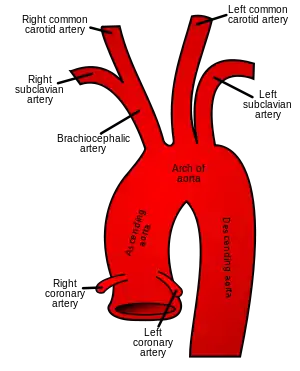Descending aorta
The descending aorta is part of the aorta, the largest artery in the body. The descending aorta begins at the aortic arch and runs down through the chest and abdomen. The descending aorta anatomically consists of two portions or segments, the thoracic and the abdominal aorta, in correspondence with the two great cavities of the trunk in which it is situated. Within the abdomen, the descending aorta branches into the two common iliac arteries which serve the pelvis and eventually legs.
| Descending aorta | |
|---|---|
 Plan of the branches. | |
 The thoracic aorta, viewed from the left side. | |
| Details | |
| Precursor | Dorsal aorta |
| Source | Ascending aorta |
| Branches | Thoracic aorta Abdominal aorta |
| Identifiers | |
| Latin | Aorta descendens, pars descendens aortae |
| TA98 | A12.2.10.001 |
| TA2 | 4185 |
| FMA | 3784 |
| Anatomical terminology | |
The ductus arteriosus connects to the junction between the pulmonary artery and the descending aorta in foetal life. This artery later regresses as the ligamentum arteriosum.[1][2]
See also
References
This article incorporates text in the public domain from page 598 of the 20th edition of Gray's Anatomy (1918)
- Rubin, Raphael; Strayer, David S., eds. (2008). Rubin's Pathology: Clinicopathologic Foundations of Medicine (5th ed.). Philadelphia: Lippincott Williams & Wilkins. p. 442. ISBN 9780781795166.
- Naidich, David P.; Webb, W. Richard; et al., eds. (2007). Computed Tomography and Magnetic Resonance of the Thorax (4th ed.). Philadelphia: Lippincott Williams & Wilkins. p. 100. ISBN 9780781757652.
External links
- Anatomy figure: 19:04-03 at Human Anatomy Online, SUNY Downstate Medical Center – "Left side of the mediastinum."